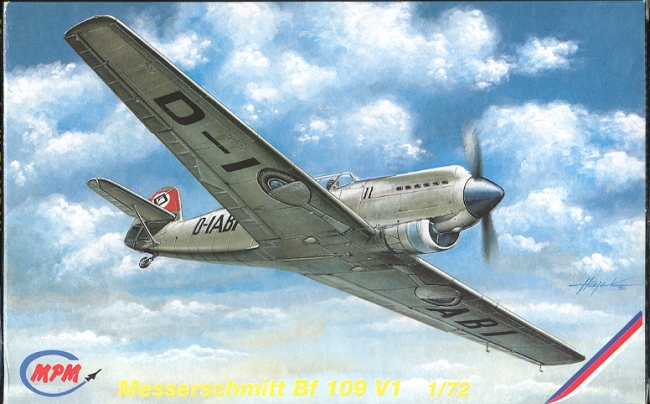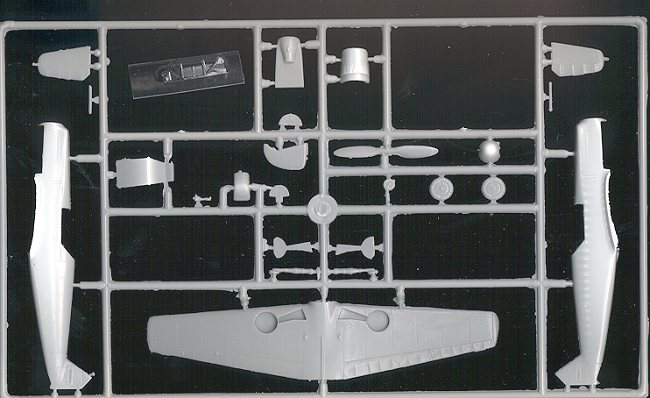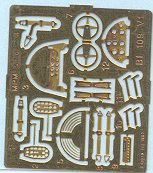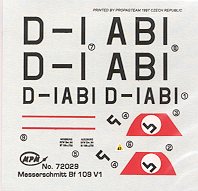
|
KIT: |
MPM 1/72 Bf-109v1 |
|
KIT # |
72029 |
|
PRICE: |
$12.98 |
|
DECALS: |
One aircraft |
|
REVIEW & |
|
|
NOTES: |
Short run kit |

|
HISTORY |
First flown in September of 1935, the Bf-109v1 was the start of a long line of over 33,000 aircraft that fought from day one to the end of the Second World War. Basically an extension of Willy Messerschmitt's Bf-108 cabin monoplane, the 109 required the help of the British to get flying. Unable to find a suitable engine in time, a Rolls Royce Kestrel was put in place of the DB 600 for which the aircraft was designed. This gave the plane a very unique look that wasn't duplicated until after the war when the Spanish installed Rolls-Royce Merlins into their 109s.
The 109 was built to compete against three other aircraft to be the new Luftwaffe's first monoplane fighter. The Fw-159 and Ar-80 were designs that were doomed to failure, mostly because of they were outmoded. The real competition to the 109 was the Heinkel He-112. The competition was fierce, but the 109 eventually won out. Not because it was the best, but because it could be built cheaper than the 112. It would have been interesting to see how the war would have turned out had the longer ranged and more ruggedly built 112 been the main fighter of the Luftwaffe, especially during the Battle for Britain.
|
THE KIT |

MPM has been a boon to those of us who like to built unusual kits. Were it not for these short run models, there is no way in the world that we would ever see any of the prototypes such as the 109v1 ever reach plastic. As you can see from the image above, it is quite typical of the genre. Thick attachment points, thick plastic (note the one-piece wing), flash on the parts and a vacuform canopy. With only 23 plastic parts you wouldn't expect it to be much trouble to build. However, I can tell you from experience that sometimes, these kits will test your skills to the limit!
 Besides the
plastic bits, there is a small fret of etched brass. On this fret you will find
things like instrument panel, trim wheels, seat harness, rudder pedals, oleo
scissors, aileron mass balances, and an engine intake grille. There is
also the engine instrument film that you glue behind the brass instrument panel.
Besides the
plastic bits, there is a small fret of etched brass. On this fret you will find
things like instrument panel, trim wheels, seat harness, rudder pedals, oleo
scissors, aileron mass balances, and an engine intake grille. There is
also the engine instrument film that you glue behind the brass instrument panel.
 Instructions are
more than adequate to build the kit. The instructions are well laid out and
logical, with color callouts in Humbrol numbers. Believe it or not, you have two
schemes in which to paint this aircraft. One in overall RLM 63 light grey and
the other with a dark blue underside to the fuselage. Decals are by Propagteam
so you know that they are well made and thin. The swastika is given in two
pieces that you assemble in the tail band. Conversely, you can use an Xtracolor
aftermarket sheet for this or paint on the tailband, which should look a lot
more convincing.
Instructions are
more than adequate to build the kit. The instructions are well laid out and
logical, with color callouts in Humbrol numbers. Believe it or not, you have two
schemes in which to paint this aircraft. One in overall RLM 63 light grey and
the other with a dark blue underside to the fuselage. Decals are by Propagteam
so you know that they are well made and thin. The swastika is given in two
pieces that you assemble in the tail band. Conversely, you can use an Xtracolor
aftermarket sheet for this or paint on the tailband, which should look a lot
more convincing.
It is a kit that should be within the abilities of nearly any modeler and one that could be a good introduction to multi-media modeling.
|
REFERENCES |
German Aircraft of the Second World War, by JR Smith & Antony Kay, Putnam, 1978 (3rd Edition)
Review copy courtesy of me and my wallet!
If you would like your product reviewed fairly and quickly by a site that has over 2,000 visits a day, please contact me or see other details in the Note to Contributors.